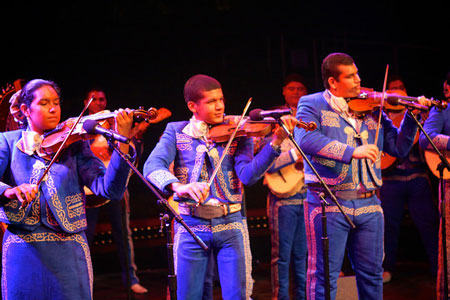 Editor’s note: Russell Rodriguez, ACTA’s Apprenticeship Program Manager, is also a well-established mariachi musician and Ph.D in Anthropology. His own artistic practice began in his youth with folklorico dance in San Jose, California, in his mother’s dance troupe, Los Mestizos. Eventually, his path led him to folklorico choreographers such as Ramón Morones, Susan Cashion, Rafael Zamarripa, and musical masters Artemio Posadas, Juan F. Díaz, Victor Cardenas, Felix Oseguera, and Andres Flores. This article is both a reflection on the inside experience of teen learning and its context as well as reflections on the larger implications of arts practice for second- and third-generation Americans of immigrant parents.
Editor’s note: Russell Rodriguez, ACTA’s Apprenticeship Program Manager, is also a well-established mariachi musician and Ph.D in Anthropology. His own artistic practice began in his youth with folklorico dance in San Jose, California, in his mother’s dance troupe, Los Mestizos. Eventually, his path led him to folklorico choreographers such as Ramón Morones, Susan Cashion, Rafael Zamarripa, and musical masters Artemio Posadas, Juan F. Díaz, Victor Cardenas, Felix Oseguera, and Andres Flores. This article is both a reflection on the inside experience of teen learning and its context as well as reflections on the larger implications of arts practice for second- and third-generation Americans of immigrant parents.
Popular Icons & Mexicanidad
Growing up in a Mexican family in the United States during the 1960s and 1970s, we were exposed to the youthful artistry of Donny and Marie Osmond and, of course, Michael Jackson. Later singers such as Luis Miguel, Lucero, and the boys of Menudo, who sang in Spanish, intrigued our minds with their love songs that seemed so innocent. Teen idols and young contemporary artists continue to fill our perception of youthful innocence, however, so many times we see the devastating effects of fame that overwhelm those that become devoured by the industry of popular capitalist culture. One of the few artists that has demonstrated a healthy growth in talent, artistry, business sense, and adaptation to fame is Pepe Aguilar, the son of legendary ranchera singers and film stars Antonio Aguilar and Flor Silvestre. Unique about his career is that he apprenticed with both his parents for many years, participating in the familial concert and jaripeos (rodeo type presentations) for which the Aguilar family was famous throughout Mexico and the United States. As a child he was immediately integrated into the spectacular shows the family presented, sharing the stage with his brother, parents, and other popular mariachi and ranchera singers who were included in the concerts during the 1970s and up to the 1980s. What is clear about the image of Pepe Aguilar is that he carries the tradition, the humility, and the talent of his parents and family when he sings with mariachi musicians. Many fans of these shows always saw this family as solid, wholesome, and as the embodiment of Mexicanidad (that which is culturally Mexican). Though he is considered a pop star, a contemporary musician, teen idol, his training during his teen years embedded various characteristics and a way of knowing that informs his current career as an artist.
There exist very few people that are widely recognized who have grown up learning and practicing traditional expressions like Pepe Aguilar. Nevertheless, there are undoubtedly many who have and continue to experience traditional forms as teens throughout the United States.
These are things I need to do: Gorlia Xiong, Hmong Youth Leader
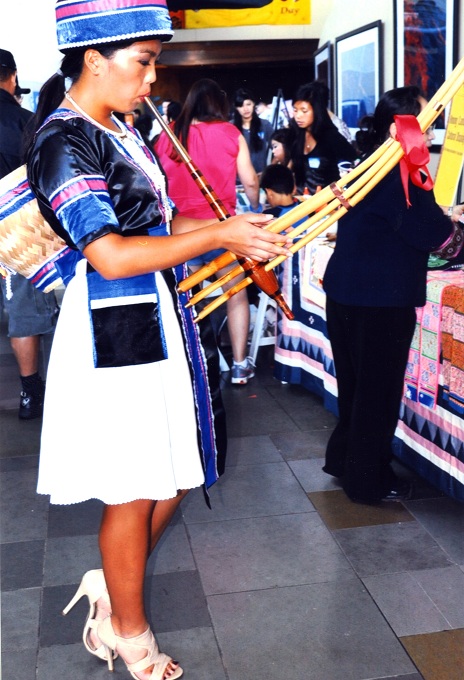 The manner in which teen traditional artists and practitioners learn today illuminates different types of relationships that traditional forms have established within the larger cultural fabric of the United States. For example, Gorlia Xiong, a student at UC Riverside has been mentoring with her father, Wang Xiong, on the Hmong qeej—a type of reed mouth organ that utilizes six bamboo pipes, or chambers, producing a unique quality of sound—since she was 12. The engagement with this traditional instrument and practice has become much more than lessons in music and technique, but rather a doorway into a collective memory that reconnects to a homeland in Laos. It also provides a wonderful opportunity in developing a bonding relationship with her father and mother (who support and nurture her development as a musician and culture bearer) and their way of knowing. In addition to Gorlia’s enculturation into US society by simply growing up in the United Sates, she also is provided a different communicative stream of knowledge which ties her to adults with different understandings of life that complement and at times compete with what the societal norms dictate within the educational system in the United States. The ability to play and dance (produce music) with an intergenerational group of people in one’s cultural group provides a foundation of moral instruction, which will also informs the manner in which one learns, communicates, shares, and thinks; something that will be utilized in other realms of learning.
The manner in which teen traditional artists and practitioners learn today illuminates different types of relationships that traditional forms have established within the larger cultural fabric of the United States. For example, Gorlia Xiong, a student at UC Riverside has been mentoring with her father, Wang Xiong, on the Hmong qeej—a type of reed mouth organ that utilizes six bamboo pipes, or chambers, producing a unique quality of sound—since she was 12. The engagement with this traditional instrument and practice has become much more than lessons in music and technique, but rather a doorway into a collective memory that reconnects to a homeland in Laos. It also provides a wonderful opportunity in developing a bonding relationship with her father and mother (who support and nurture her development as a musician and culture bearer) and their way of knowing. In addition to Gorlia’s enculturation into US society by simply growing up in the United Sates, she also is provided a different communicative stream of knowledge which ties her to adults with different understandings of life that complement and at times compete with what the societal norms dictate within the educational system in the United States. The ability to play and dance (produce music) with an intergenerational group of people in one’s cultural group provides a foundation of moral instruction, which will also informs the manner in which one learns, communicates, shares, and thinks; something that will be utilized in other realms of learning.
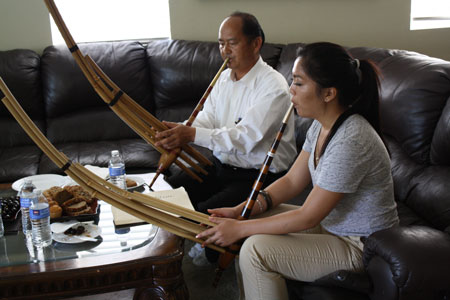 The various cultural streams of knowledge that formulate within Gorlia has provided strong grounding for her to position herself within various social locations as a young women, as a student, as a youth within the United States, as member of the Hmong diaspora. Gorlia states that she understands how she is different. “Many of my friends ask me why I do so many things that overwhelm me.” and she responds, “These are things I need to do.” This is in reference to working hard in college and to attending and teaching classes at the Hmong Association of Long Beach, in which both she and her father are central figures. She interestingly refers to her work at the Hmong cultural center as a “hobby” because “as a teenager, I always grew up learning from my parents, who were strict. They would push me to do well in school, so I never paid much attention to new pop artists, movies, or US popular culture. The goal was how well can I do in school—good grades, school, school, school. The cultural dancing and singing are still hobbies and talents. Even though I am invested in the culture, my family came here so I can do well in school.” She nevertheless holds the cultural practices central to her identity with the same passion she has for education. She states, “while my friends are worried what is the next chapter in their lives, sometimes without worrying what they are doing currently, I think of what is traditionally going to happen; how are we going to practice and preserve our culture when our parents aren’t here?” This concern with cultural preservation makes evident how the Hmong culture maintains a centrality to her character and to what she aspires to be.
The various cultural streams of knowledge that formulate within Gorlia has provided strong grounding for her to position herself within various social locations as a young women, as a student, as a youth within the United States, as member of the Hmong diaspora. Gorlia states that she understands how she is different. “Many of my friends ask me why I do so many things that overwhelm me.” and she responds, “These are things I need to do.” This is in reference to working hard in college and to attending and teaching classes at the Hmong Association of Long Beach, in which both she and her father are central figures. She interestingly refers to her work at the Hmong cultural center as a “hobby” because “as a teenager, I always grew up learning from my parents, who were strict. They would push me to do well in school, so I never paid much attention to new pop artists, movies, or US popular culture. The goal was how well can I do in school—good grades, school, school, school. The cultural dancing and singing are still hobbies and talents. Even though I am invested in the culture, my family came here so I can do well in school.” She nevertheless holds the cultural practices central to her identity with the same passion she has for education. She states, “while my friends are worried what is the next chapter in their lives, sometimes without worrying what they are doing currently, I think of what is traditionally going to happen; how are we going to practice and preserve our culture when our parents aren’t here?” This concern with cultural preservation makes evident how the Hmong culture maintains a centrality to her character and to what she aspires to be.
Music helps me keep focused: Fabian Narez, Teen Mariachi Musician
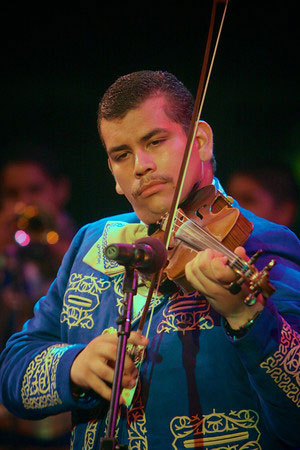 Another example is Fabian Narez, a young man working within the tradition of mariachi music, who just graduated from San Fernando Senior High School. Though he did not learn from his father or mother, mariachi music has become a central aspect of his life. Fabian was exposed and learned this tradition through arts education programming in San Fernando. Nevertheless, as a teenager he has worked his way through different spaces of mariachi practice, which includes learning and working with student groups and working groups in the variety of venues and contextual settings (private home celebrations, weddings, restaurants, school events). His indoctrination occurred by accident. Wanting to enroll in a creative writing class in middle school, Fabian was asked to take a music class because the writing class was full. Agreeing, Fabian began lessons on the violin and cello. After a year of western classical lessons, Fabian was encouraged to attend a mariachi class led by a well-known mariachi educator in San Fernando, Rudy Vasquez. After working through the different groups and spaces, Fabian ultimately gained a spot with Mariachi Tesoro, which is an all-star youth group that emerges from the nationally recognized Mariachi Master Apprentice Program. In this mentoring program, he studied and worked with a team of musicians that are members of the internationally known Mariachi Los Camperos de Nati Cano. His teachers are the who’s who of mariachi music that include Sergio Alonso, Jimmy Cuellar, Juan Jimenez, under the direction of, and the auspices of Nati Cano himself. This is the equivalent to a high school jazz program being taught by Bradford Marsalis, Jon Faddis, Ron Carter, directed by Chick Corea, and with the backing and blessing of Count Basie.
Another example is Fabian Narez, a young man working within the tradition of mariachi music, who just graduated from San Fernando Senior High School. Though he did not learn from his father or mother, mariachi music has become a central aspect of his life. Fabian was exposed and learned this tradition through arts education programming in San Fernando. Nevertheless, as a teenager he has worked his way through different spaces of mariachi practice, which includes learning and working with student groups and working groups in the variety of venues and contextual settings (private home celebrations, weddings, restaurants, school events). His indoctrination occurred by accident. Wanting to enroll in a creative writing class in middle school, Fabian was asked to take a music class because the writing class was full. Agreeing, Fabian began lessons on the violin and cello. After a year of western classical lessons, Fabian was encouraged to attend a mariachi class led by a well-known mariachi educator in San Fernando, Rudy Vasquez. After working through the different groups and spaces, Fabian ultimately gained a spot with Mariachi Tesoro, which is an all-star youth group that emerges from the nationally recognized Mariachi Master Apprentice Program. In this mentoring program, he studied and worked with a team of musicians that are members of the internationally known Mariachi Los Camperos de Nati Cano. His teachers are the who’s who of mariachi music that include Sergio Alonso, Jimmy Cuellar, Juan Jimenez, under the direction of, and the auspices of Nati Cano himself. This is the equivalent to a high school jazz program being taught by Bradford Marsalis, Jon Faddis, Ron Carter, directed by Chick Corea, and with the backing and blessing of Count Basie.
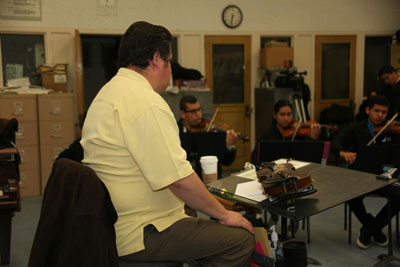
Though mariachi was not a family tradition for Fabian, it was still something that both his parents fully supported and found value to his educational development. Fabian, similar to Gorlia, puts his education first, stating, “I understand the sacrifice they (his parents) made to come here so that I can be focused and have these options (through education).” He continues, “Music helps me keep focused and out of trouble.” Fabian makes reference to his friends and other youth who “were always looking for ‘something to do.'” The mariachi also provided a special circle of friends that he “trusts.” “I wasn’t popular; I wouldn’t hang out with too many kids my age. In high school, there were many bad influences, not worth my time. I would be choosy with my friends. So most of my friends I met in mariachi… they are my true friends, I can trust them. When I graduated, a bunch of them came out to my graduation.”
Fabian has shared many incredible experiences through participating in this traditional practice. A highlight was playing at the White House for the First Lady, Michelle Obama, when the Mariachi Master Apprentice Program received the National Arts & Humanities Youth Program Award. Nevertheless, this young man maintains a very gracious manner of respect and humility, as does Gorlia. These two artists, who have entered into and maintain their traditional practice in a very different manner, both preserve a strong character of self-determination and dignity for their art, culture, family, and themselves. They both demonstrate how their respective cultural practice helps them stay focused to achieve the goals they make for themselves in life.
Analyzing their paths to the future
Gorlia and Fabian also exhibit a maturity in examining where they are in their lives. In a very interesting way, when asked to provide some closing thoughts to the interviews that I did with them—in which I asked them about their thoughts on their relationship with their traditions, with US popular culture, with their friends, family, culture—they both included that they are critically analyzing their paths to the future. Fabian stated, “I see that I am, every day, preparing for my future, while others are living day by day. I know what I want to do. I may not know what my future is, but I know a path that I will take. I am cautious; I will take my time to do things. You need to realize what you are doing.” Gorlia coincidently shares, in addition to her statement above, “I reminisce about the past and the future. As a teenager, I always think ahead of myself. I always analyze what I will do before I do it—think twice before you jump.” It seems as teenagers these two traditional artists make choices that are filtered through a thought process rather than based on emotional gratification or spontaneity. This may come off a little prudish or somewhat sheltered, but I think it is safe to say they are living life to the fullest, because the traditional expression itself provides many opportunities for them to experience life in a vibrant, fun-filled, and deep manner that are not available to many teenagers.
***************
The accounts of Gorlia and Fabian are model experiences and may sound a bit ideal or romantic. We can be assured that not all youth engaged in traditional practices come to the realizations of these two. We can be confident, however, that participating in these spaces most always provides a strong potential for youth to develop in very productive ways, learning beyond the institutional and popular ways of thinking in the United States (ways of thinking that often times position people of color and immigrant and refugee communities in a lower social status). Growing up in the United States and apprenticing as teens in the traditional arts provides multiple foundations for youth, like Gorlia and Fabian, offering them wonderful paths and streams of knowledge to critically analyze where they can go.
We are at a point in which our teens can use all the support they can receive. We have to make sure we continue teaching them to recognize the available public, private, and personal opportunities that create different types of participation in life and offer broad visions of a future. At the same time that traditional arts provides much potential for teens to develop as productive contributors to community and society at large, it is also evident that the participation of children, teens, and youth guarantee the preservation and the development of traditional expressions, such as the Hmong qeej and mariachi music. With this in mind, we can also recognize that the teens’ contribution to the traditional arts and practice is a valued resource, which in a direct manner helps define the cultural landscape of the United States.
